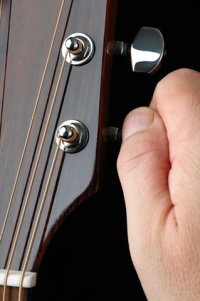|
Acoustic Guitar Tuning - How do you do it?
There are a few different approaches to tuning. Standard TuningFor beginners, I recommend using the standard tuning method using an electric tuner. Standard tuning is by far the most popular method on a 6-string acoustic guitar. It consists of tuning to the following notes: E-A-D-G-B-E. Not only will all the strings be in tune relative to each other string, but all the strings will be in pitch. If your acoustic guitar is in pitch and you are playing with other instruments using the same tuning method, your instrument will be in tune with these other instruments. Korg offers a great, inexpensive acoustic guitar tuner to carry in your gig bag. Below is a video demonstration of standard tuning with an electric tuner.
Comparative TuningComparative tuning is a method of comparing the tune of one string to another. In other words, tune one string at a time using another string as a reference note. For example, the low E string has an A note at the 5th fret which means you can tune your A string using this reference note, and then tune the low E string until the A note at the 5th fret matches the A string. This should mean that the low E string is now in tune as well. Then play the A string at the 5th fret to produce a D to tune the D string and so on. This pattern continues with all of the strings except the B string which breaks this pattern; rather, a B is actually played on the 4th fret on the G string. Below is a video demonstration of the comparative tuning method.
Tune Acoustic Guitar OnlineHere are several, really cool visual tools to
tune acoustic guitar online.
Tune to a KeyboardDo you have access to a piano? If so, tune to its keyboard.
Other Tuning ResourcesAcoustic Guitar Tuner - Tuner Reviews Table of Contents: LESSONS
|





 Why is acoustic guitar tuning important? If your acoustic guitar is not in tune, you may be "fingering" correctly but your instrument may be playing the wrong notes. How frustrating! So, take a couple moments now and tune your acoustic guitar.
Why is acoustic guitar tuning important? If your acoustic guitar is not in tune, you may be "fingering" correctly but your instrument may be playing the wrong notes. How frustrating! So, take a couple moments now and tune your acoustic guitar.





